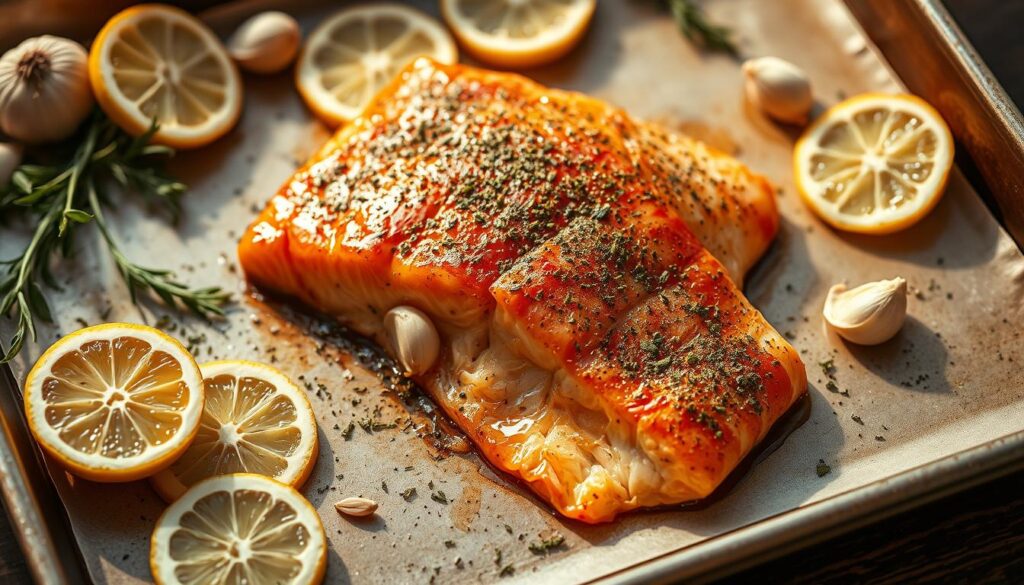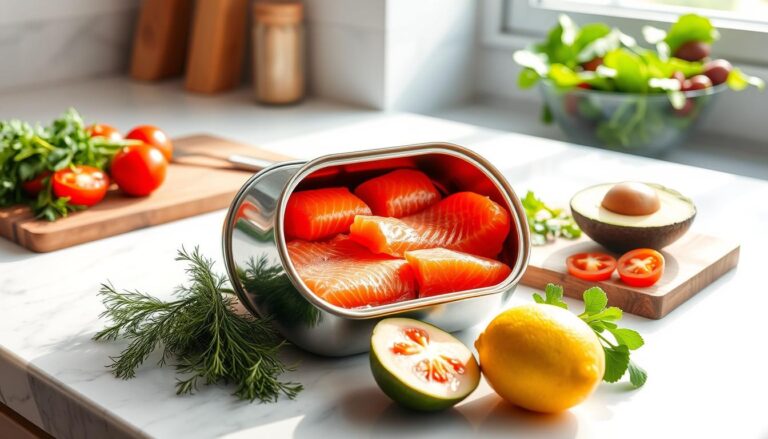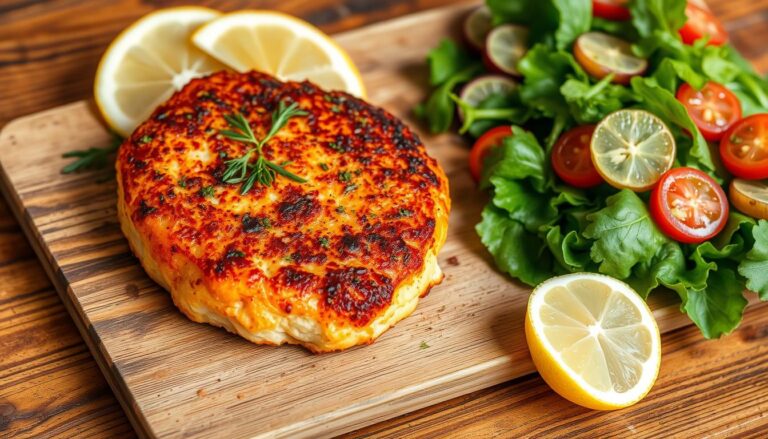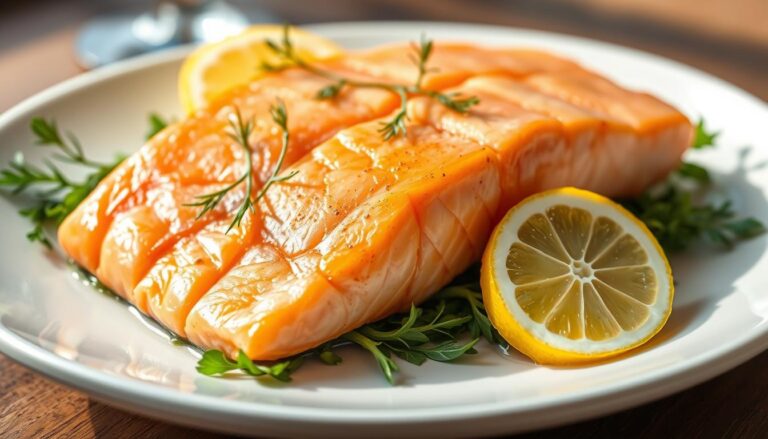Simple Lemon Garlic Salmon for a Delicious Seafood Feast
Imagine a busy weeknight turning into a fun cooking adventure. A lemon garlic salmon recipe can change your dinner plans. The smell of garlic and lemon makes your kitchen smell amazing, making your meal special.
Salmon is more than just a fish; it’s full of good stuff for your body. This recipe is easy yet fancy, perfect for families and cooking lovers.
Key Takeaways
- Preparation takes just 20 minutes from start to finish
- Perfect for quick weeknight dinners or special occasions
- Packed with essential nutrients and protein
- Versatile recipe that can be customized to taste
- Requires minimal cooking skills and basic ingredients
Understanding the Magic of Lemon Garlic Salmon
Salmon is more than a tasty meal; it’s a journey of taste and health. To make the perfect salmon, you need to know its special traits and the best ways to season it.
What Makes This Dish Special
Lemon garlic salmon is a true kitchen gem. The mix of zesty lemon and garlic turns a simple fish into a gourmet dish. This duo is the best for salmon because it adds:
- Bright, citrusy notes from fresh lemon
- Rich, savory undertones from minced garlic
- Perfectly balanced flavor enhancement
Health Benefits of Salmon
Salmon is not just tasty; it’s also packed with nutrients. Here’s a look at its nutritional benefits:
| Nutrient | Amount per Serving | % Daily Value |
|---|---|---|
| Calories | 307 kcal | 15% |
| Protein | 34 g | 68% |
| Omega-3 Fatty Acids | High | Excellent |
Why This Recipe Works
Seasoning salmon right is all about boosting its natural taste. The secret is to season it just right, so it doesn’t overpower its delicate flavor. Lemon and garlic do this by:
- Cutting through the salmon’s rich taste
- Adding depth to the dish
- Bringing a light, refreshing touch
“Cooking is about passion, so it may look slightly temperamental in a way that it’s too assertive to the naked eye.” – Gordon Ramsay
Whether you’re an experienced cook or just starting, this lemon garlic salmon recipe is easy to follow. It’s all about finding the right balance of flavors and respecting the fish’s natural taste.
Essential Ingredients for Perfect Salmon
To make the perfect salmon marinade, you need the right ingredients. These ingredients turn a simple meal into a feast for the senses. Choosing top-notch components is key to bringing out the fish’s natural taste.
Now, let’s look at the best salmon marinades and what makes them special:
- Fresh Salmon Fillet: Choose a 2-3 pound skinless salmon, preferably wild-caught for the best flavor
- Fresh Lemons: 3 large lemons for zest, juice, and garnish
- Unsalted Butter: Adds a creamy texture
- Garlic: 5 chopped cloves for a strong flavor
- Honey: Brings a touch of sweetness
- Herbs: Fresh oregano for a fragrant aroma
- Seasonings: Kosher salt and fresh ground pepper
Your marinade recipe should mix flavors well. The mix of lemon’s tang, garlic’s punch, and honey’s sweetness works together beautifully. It enhances the fish’s natural taste.
“The secret to an outstanding salmon dish lies in the quality of your ingredients.”
Choose fresh ingredients for the best taste. Wild-caught salmon tastes better than farmed. Make sure your garlic is fresh, lemons are bright, and butter is top-notch.
Pro tip: Marinate your salmon for 30 minutes before cooking. This simple step makes your marinade go from good to great.
Kitchen Tools and Equipment Needed
Preparing a delicious salmon dish needs the right kitchen equipment. Whether you’re cooking frozen salmon or baking a fresh fillet, the right tools make cooking smooth and fun.
Essential Cooking Tools
To prepare your salmon well, you’ll need several key tools:
- Baking sheet or rimmed sheet pan
- Aluminum foil or parchment paper
- Mixing bowls
- Sharp chef’s knife
- Cutting board
- Measuring cups and spoons
Temperature Control Equipment
When cooking frozen salmon, precision is key. An instant-read thermometer is crucial for checking the internal temperature. It should reach 145°F for safe and perfect cooking.
Optional Equipment for Enhanced Results
To improve your salmon cooking, consider these extra tools:
- Fish spatula for delicate handling
- Lemon zester
- Kitchen tongs
- Silicone basting brush
“The right tools can transform your cooking from good to extraordinary.”
For those wondering how to bake frozen salmon, these tools will help. Remember, cooking frozen salmon needs slight adjustments in technique and time compared to fresh fillets.
Preparing Your Salmon for Cooking
Getting your salmon ready for a delicious meal requires careful preparation. Knowing how to take the skin off salmon can improve your cooking skills. A typical salmon fillet has about 200-250 calories. This makes it a great choice for those watching their diet.

- Select fresh, high-quality salmon fillets
- Inspect the fish for any remaining scales
- Pat the salmon dry with paper towels
- Remove skin if desired using a sharp knife
Pro tip: Remove salmon skin by placing the fillet skin-side down on a cutting board and carefully sliding a sharp knife between the flesh and skin.
| Nutrition Facts (4 oz serving) | Amount |
|---|---|
| Calories | 206 |
| Protein | 22g |
| Total Fat | 13g |
| Omega-3 Fatty Acids | 2.3g |
“Proper preparation is the secret to a perfectly cooked salmon fillet” – Chef’s Wisdom
Knowing about salmon fillets calories helps you make better food choices. A 4-ounce serving gives you important nutrients. It keeps your meal balanced and healthy.
Creating the Perfect Garlic Butter Sauce
Making the ultimate lemon butter garlic sauce can take your salmon dish to the next level. It’s all about using top-notch ingredients and simple mixing techniques. These steps unlock amazing flavors.
Your perfect sauce for salmon starts with the right mix of ingredients. A classic lemon butter garlic sauce needs the right parts to make your seafood dish stand out.
Sauce Ingredients Selection
For a great sauce, focus on these key items:
- High-quality unsalted butter
- Fresh garlic cloves
- Freshly squeezed lemon juice
- Fresh herbs like parsley or dill
- Optional white wine for depth
Mixing Techniques
Making a smooth sauce is all about gentle heat and careful mixing. Start by melting butter slowly. Then add minced garlic and cook until it smells great. Add lemon juice and herbs, whisking all the time to mix well.
Flavor Enhancement Tips
“The difference between a good sauce and a great sauce is in the details.” – Professional Chef
To make your sauce even better, try these tips:
- Roasting garlic for deeper flavor
- Using fresh herbs instead of dried
- Balancing acidity with a pinch of salt
- Adding a splash of white wine
Pro tip: You can make your lemon butter garlic sauce ahead of time. Store it at room temperature for easy meal prep.
Step-by-Step Baking Instructions
Preparing the perfect salmon needs precision and care. To bake salmon at 375°F, follow these expert tips for a delicious meal. The right temperature is key for that flaky texture.

- Preheat your oven to 375°F (190°C)
- Prepare a baking sheet lined with parchment paper
- Pat salmon fillets dry with paper towels
- Season generously with salt and pepper
- Drizzle with olive oil or melted butter
The baking process is straightforward but requires attention to detail. Salmon usually cooks in 10-12 minutes, depending on its thickness.
Pro tip: The internal temperature should reach 145°F for perfect doneness!
| Salmon Thickness | Cooking Time | Internal Temperature |
|---|---|---|
| ½ inch | 8-10 minutes | 125°F-135°F |
| 1 inch | 12-15 minutes | 135°F-145°F |
Remember, slightly undercooked is better than overcooked when it comes to salmon! Look for the fish to become opaque and flake easily with a fork. Your perfectly baked salmon awaits!
Alternative Cooking Methods
Trying new cooking ways can make your salmon dish stand out. Baking is common, but other methods can add special flavors and textures to your meal.
Salmon is a great fish for many cooking styles. Let’s explore some new ways to cook it, beyond baking.
Pan-Searing Technique
Pan-searing is a fantastic method for cooking salmon. You can do it in a skillet or oven in foil. Here’s how to get a crispy outside:
- Use a nonstick skillet heated to medium-high
- Season salmon fillets with salt and pepper
- Cook for 4-5 minutes per side
- Add 1 tablespoon of butter after turning the fish
Grilling Method
Grilling adds a smoky taste to your salmon. Here’s how to grill it right:
- Preheat grill to medium-high heat
- Clean and oil grill grates
- Cook salmon for 5 minutes on each side
- Aim for an internal temperature of 145°F
Broiling Options
Broiling is quick and makes the salmon’s top layer caramelized:
| Salmon Thickness | Broiling Time |
|---|---|
| Thin fillets (1/2 inch) | 2-3 minutes per side |
| Thick fillets (1 inch) | 3-4 minutes per side |
Each cooking method has its own perks. Try them out to find your favorite way to cook salmon!
“Cooking is an art, and salmon is your perfect canvas.” – Culinary Experts
Perfect Side Dishes to Complement Your Salmon
Choosing the right sides for your salmon recipe can make a big difference. The right side dishes can turn a simple meal into a feast for the senses.
- Roasted Vegetable Medley
- Creamy Garlic Mashed Potatoes
- Grilled Asparagus with Lemon Zest
- Quinoa Salad with Fresh Herbs
- Crispy Garlic Butter Bread
Your sides should enhance the salmon’s flavor and add nutrients. Pro tip: Mix sides with different textures and tastes for a lively meal.
“The right side dish can elevate salmon from a simple protein to a gourmet meal.” – Culinary Experts
| Side Dish | Preparation Time | Difficulty Level |
|---|---|---|
| Roasted Brussels Sprouts | 20 minutes | Easy |
| Quinoa Pilaf | 25 minutes | Intermediate |
| Garlic Parmesan Risotto | 35 minutes | Advanced |
Think about what’s in season and what you like when picking sides for salmon. Try out different pairings to find your favorite.
Storage and Reheating Guidelines
Knowing how to store and reheat salmon is key to enjoying it safely and well. Proper storage keeps the salmon’s flavor and prevents illness.
Cooked salmon can stay in the freezer for up to 3-4 months. Use an airtight container or freezer bag to avoid freezer burn.
Refrigeration Storage Tips
- Store salmon in an airtight container
- Refrigerate within 2 hours of cooking
- Consume within 3-4 days
- Keep refrigerator temperature at 41°F or below
Freezing Guidelines
| Storage Method | Duration | Recommended Technique |
|---|---|---|
| Refrigerator Storage | 3-4 days | Airtight container |
| Freezer Storage | 3-4 months | Freezer bag or sealed container |
For frozen salmon in oven, thaw it in the fridge overnight. Reheat at 300°F for 5-7 minutes to keep it moist.
“The secret to great reheated salmon is gentle, slow heating to preserve moisture and flavor.” – Culinary Expert
Reheating Methods
- Oven method: 300°F for 5-7 minutes
- Skillet method: Medium-low heat for 4-5 minutes
- Cover while reheating to retain moisture
Pro tip: Always ensure the internal temperature reaches 165°F when reheating to guarantee food safety.
By following these guidelines, your lemon garlic salmon will stay fresh and tasty. Enjoy it the next day or weeks later from the freezer.
Common Cooking Mistakes to Avoid
Preparing the perfect salmon needs skill and focus. Many home cooks face challenges that can ruin a meal. Knowing how to tell if salmon is cooked and avoiding common mistakes can improve your cooking.

Cooking salmon can be tricky, but with the right knowledge, you can master it. It’s important to know when salmon is cooked for both taste and safety.
Temperature Control Challenges
Temperature is key in cooking salmon. Overcooking makes the fish dry and tough. The ideal internal temperature is 145°F. Use a meat thermometer for accuracy.
- Avoid high heat that can quickly dry out the fish
- Cook salmon at medium heat for even cooking
- Remove from heat when it just begins to flake
Seasoning Missteps
Seasoning is crucial for your salmon dish. Salting too early can dry out the fish, while waiting too long can make it taste bland. Professional chefs suggest salting just before to keep it moist and flavorful.
| Seasoning Mistake | Consequence | Solution |
|---|---|---|
| Over-salting | Ruins dish flavor | Use minimal salt, taste as you go |
| Early salting | Moisture loss | Salt immediately before cooking |
Timing Troubles
Cooking time greatly affects salmon’s texture and taste. Timing is everything when cooking this delicate fish. Most salmon cuts need about 4-6 minutes per side, depending on thickness.
Pro tip: Watch for the salmon to turn from translucent to opaque pink, indicating it’s perfectly cooked.
By avoiding these common mistakes, you’ll make restaurant-quality salmon. It will be moist, flavorful, and perfectly cooked every time.
Professional Chef Tips and Tricks
Want to make your salmon dish stand out? Follow these expert tips to turn your seafood into a masterpiece. When looking for the best salmon, choose fillets that are bright and firm. A good salmon picture can also help you spot quality fish.
Professional chefs have secrets to make your salmon taste like it’s from a restaurant:
- Bring salmon to room temperature before cooking for even heat distribution
- Use a fish spatula to handle delicate fillets without breaking them
- Pat salmon dry with paper towels to ensure crispy skin
- Season generously just before cooking
“The secret to perfect salmon is respecting the ingredient and understanding its delicate nature.”
Here are some key tips for picking and preparing your salmon:
- Freshness Check: Look for bright, uniform color without brown spots
- Texture Evaluation: Fresh salmon should spring back when gently pressed
- Smell Test: Fresh salmon should have a mild, ocean-like scent
| Technique | Professional Tip |
|---|---|
| Temperature Control | Cook salmon at 280°C for optimal results |
| Cooking Time | 11 minutes total cooking time recommended |
| Seasoning | Use 6 key ingredients: olive oil, lemon juice, lemon zest, garlic, Dijon mustard, salt |
Mastering salmon takes time and patience. With each try, you get closer to a dish that will wow everyone.
Conclusion
Your journey through lemon and salmon recipes has given you the skills to make seafood meals like a pro. You’ve learned different ways to cook salmon and made it into a dish fit for a restaurant. The lemon garlic salmon is so versatile, you can serve it at any time.
This recipe is not just tasty; it’s also good for you. It’s low in calories, high in protein, and easy to make. The mix of garlic, lemon, and herbs adds amazing flavor and boosts your health.
Cooking is all about learning and trying new things. Every time you make this dish, you’ll get better and find new ways to make it even better. Cooking for yourself, family, or friends will always be special with these salmon recipes.
Now you know how to make lemon garlic salmon like a pro. With the right skills and techniques, you can turn simple ingredients into amazing meals. Start cooking and enjoy the delicious adventures ahead!







